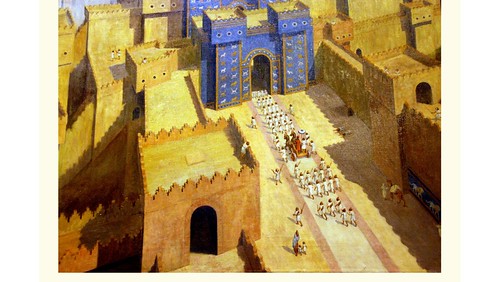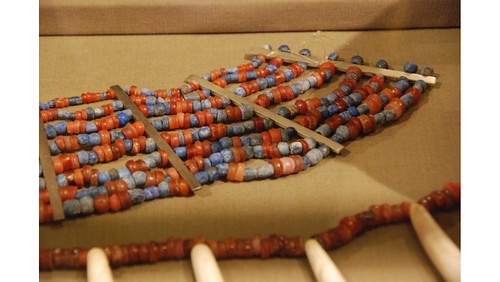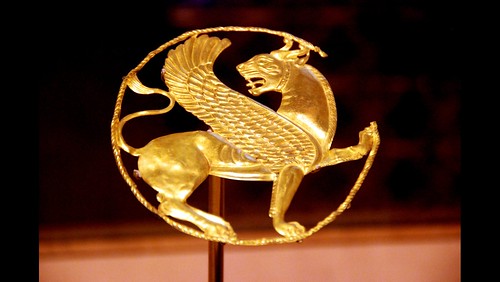Galería de Hans Ollermann
Oriental Institute, Chicago
2008_0923_180027AB-Ancient Babylon

2008_0923_175521AB

Jewelry from Tell Agrab: Shara Temple.
Ancient Mesopotamia (Iraq).
Oriental Institute, Chicago.
2008_0923_193037AB Oriental Institute

Archaemenid Gold.
Large roundel showing a winged lion.
From Ancient Ecbatana, Summerresidence of of the Archaemenid Court.
Oriental Institute, Chicago.
Content-Transfer-Encoding: quoted-printable
Content-Type: text/plain; charset=utf-8
Estimado Jesús Ascaso a quien no tengo el placer de conocer,
He tardado en contestar porque, sinceramente, me ha costado comprender tu mensaje y aún hay un aspecto que no acabo de entender, me refiero a la última parte en la que me preguntas directamente sobre los imaju, aunque supongo que se relaciona con la traducción de Faulkner "el sagrado estado del difunto" y el hecho de que no lo mencione en mi libro sobre tumbas privadas del Reino Nuevo.
Siento decir que no tengo opinión personal al respecto, lo que sé de los imaju se lo debo a otros como Allen o Shaw, aunque tampoco parece que esté muy claro pues el concepto va variando desde el Reino Antiguo y no hay una acuerdo sobre su significado. Lo que sí es evidente es que su traducción a palabras de los idiomas modernos, como sucede con ba o maat, por ejemplo, es estéril, porque el concepto en su totalidad se pierde, por eso las traducciones de Faulkner no son del todo exactas. Entre las explicaciones que conozco, me quedo con la que da Ian Shaw en The Oxford History of Ancient Egypt, que da a imaju un sentido ético aplicado a corregir las desigualdades sociales.
En cuanto a la primera parte de tu mensaje, creo que he comprendido tu crítica a mi libro, porque supongo que las citas, ambas referidas a las manifestaciones artísticas, aluden a él y no a los otros dos que mencionas. Entiendo, y corrígeme si me equivoco, que, de acuerdo con una de esas citas, mis modestas aportaciones para percibir el sentido y la forma de la decoración de las tumbas son "confusas" porque carezco del "conocimiento verdadero" y que no aporto nada de lo que dice Manuel Juaneda sobre la importancia de las manifestaciones artísticas para el conocimiento del Antiguo Egipto. Si he interpretado bien el sentido de tus palabras, no te ha gustado mi libro por todas esas razones. Está bien, acepto tus críticas, pero me guardo el derecho a rebatirlas cuando vea que no me he equivocado al interpretar tu mensaje.
Y por último, las obras de divulgación científica y/o de síntesis son muy dignas y necesarias siempre y cuando sean eso, científicas y no ficciones. Los que hemos realizado alguna no por ello hemos dejado de aportar en ellas aspectos de nuestras investigaciones, porque las hacemos, al menos ese es mi caso.
Te agradecería me aclarases si he interpretado tus palabras correctamente.
Cristina Pino
Galeria de petrus.agricola
| |
|
|
The Great Bend of the Nile from Space
The Great Bend of the Nile from Space
In terms of Egypt, there's pictures of Cairo from about 2:55 which segue into pictures of the Great Bend of the Nile at Luxor. There are stills of the Great Bend on this Nasa site. I've linked rather than cross-posted because if you hold your mouse over the daytime picture of the Great Bend it changes to night time. Be patient because the first time the transition is a bit slow - give it 20 seconds or so. Once you've swapped between the two scenes once, the pictures should be cached in your browser so you can flick between them quickly. It's interesting to compare the margins of modern habitation with the historic green, fertile strip. In rural areas habitation is bounded within the agricultural land; around Luxor on both banks development extends clearly into desert areas.
Paler still is the Valley of the Kings, showing clearly how much it has been dug over by man, particularly modern archaeologists. There is an image further down the Nasa page showing you what to look for. Armed with that knowledge, it's then very obvious on Google Maps.
View Larger Map
It's also a really good way to see the geography of the Western Valley of the Kings in relation to the main wadi. South of the Valley of the Kings, Deir el-Bahri is very visible and again the entire wadi around the Temple of Hatshepsut is noticeably paler than nearby regions backed up against the cliffs, again suggesting that man has reworked surface of Deir el-Bahri more than other areas. If you ever doubted how water has shaped the Valley of the Kings, zoom out a little and look at the next wadi north (above) the Valley of the Kings. It's easy to see how water has deposited gravel on the corners of bends and at the junctions of side valleys. The Valley of the Kings has been as affected by flooding as this wadi - it's just less obvious because the valley floor has been so altered.
For anybody not entirely familiar with the geography of the West Bank at Luxor, it's worth swapping to the Wikimapia view which labels the main sites. There are some labels in Arabic so ignore those ... unless you speak Arabic of course, but the main historical sites are labelled in English. For instance the burial ground of Dra Abu el-Naga is labelled just east of "Hatshepsut's Parking Lot".
I recommend zooming in and out. As you zoom in more labels will appear but zooming out gives a wider perspective. Just a warning though that it is a Wiki so, as with all Wikis, not all of the information is accurate - I'd suggest using it as something for enjoyment rather than study.
Tomb Robbers in KV62 - Hawass Video
In the fourth and final part of this video series from Heritage Key, Dr Hawass mentions the robberies of KV62, the tomb of Tutankhamun. He believes it was saved ultimately be the construction of tomb KV9.
That's possible, but doesn't explain how KV62 escaped robbery before then. Perhaps the security in the Valley of the Kings was robust during the early 19th Dynasty, but as Tutankhamun's tomb was robbed in the 18th Dynasty, it seems somewhat unlikely. Personally I prefer the theory that Horemheb discouraged mention of Tutankhamun along with the Amarnan royalty so the tomb wasn't well-known, and that KV62 was covered by debris from a flash flood as suggested by Stephen Cross. Admittedly, debris from the construction of the tomb of Ramses VI may have helped to protect the tomb, but I think it was a combination of all of these factors.
At the end of the video, Dr Hawass ponders the incalculable treasures that could have been in the tomb of Ramses VIII and which tombs could still be found, and which could be intact. He mentions Neferiti and Amenhotep I, which is interesting. There's no mention of Ramses VIII which last year was theorised (by Dr Hawass) as one of the tombs found in the Valley of the Kings.
(PS another month is slipping by without news of the DNA testing either.)
##########################################
RSS Feed de Amigos de la Egiptología
http://www.egiptologia.com/index.php?format=feed&TYPE=rss
##########################################
Foro de Discusión sobre el Antiguo Egipto
http://www.egiptologia.com/foro
Recomendamos: Proyecto Dinástico
http://www.tierradefaraones.com
--------------------------------------------------------------
LISTA DE DISTRIBUCIÓN DE AMIGOS DE LA EGIPTOLOGÍA - AE
Gestión Altas-Bajas y consulta mensajes enviados:
http://www.egiptologia.com/lista-de-distribucion.html
Moderador: Víctor Rivas egiptologia@egiptologia.com
Amigos de la Egiptología: http://www.egiptologia.com
Los mensajes de Amigos de la Egiptología son distribuidos gracias al apoyo y colaboración técnica de RedIRIS Red Académica Española - http://www.rediris.es

No hay comentarios:
Publicar un comentario